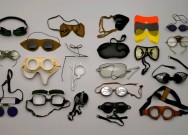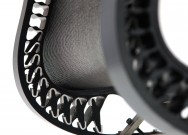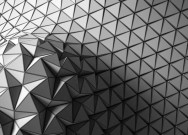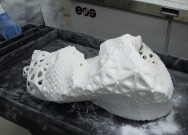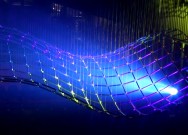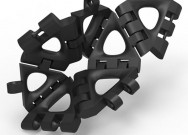Verborgene Gestaltung
Die Sammlung von Franco Clivio
No Name Design.
Die Wunderkammer von Franco Clivio
Einblick in die Ausstellung im Gewerbemuseum Winterthur
„No Name Design“ ist eine Liebeserklärung an die unscheinbaren Dinge, die uns im Alltag begleiten und ihr Dasein meist im Schatten der grossen Namen fristen, die selten im grellen Rampenlicht stehen und kaum je aufmerksame Blicke auf sich ziehen. Die Ausstellung ist Hommage und zugleich Eldorado für Liebhaber von Trouvaillen und Fundstücken, die weder blenden noch verführen wollen, sondern einfach da sind und einen aufmerksamen Beobachter wie Franco Clivio brauchen. Rund 900 zumeist kleine Gebrauchsobjekte sind in der Schau versammelt.
Der Gestalter und Dozent Franco Clivio (*1942) ist seit Jahrzehnten auch Sucher und Finder. Seine Leidenschaft gilt dem Banalen, dem scheinbar Ungestalteten. Er spürt die hohe gestalterische Qualität auf und sucht nach dem Ungewöhnlichen im Gewöhnlichen. Dazu durchstöbert er Brockenhäuser, Flohmärkte, Trödelläden oder auch Eisenwaren¬läden und Warenhäuser – immer von der Neugierde getrieben, nie von einem bestimmten Plan. Entstanden ist ein grandioses Sammelsurium von anonym gestalteten Gegenständen, die, ins rechte Licht gerückt, plötzlich Qualitäten entfalten, die gemeinhin im Verborgenen schlummern.
Die Ausstellung ist eine Art Wunderkammer mit enzyklopädischem Charakter und lehrreicher Auslegung. Präsentiert werden rund 900 zumeist kleine Objekte – beispielsweise Klappmesser, Lieblingsobjekte, Vielkönner, Greifwerkzeuge oder auch Weiterentwicklungen von alten Bekannten wie Scheren, Brillen oder Messinstrumenten. Gemeinsamer Nenner ist immer die raffinierte gestalterische Qualität, die weniger auf der guten Form denn vielmehr auf einer Besonderheit von Funktion, Material und Konstruktion beruht.
Kinematik + smarte Geometrien
Studio 7.5 Berlin
Entwicklung des Stuhl Setu für Herman Miller
vom Studio 7.5
Claudia Plikat
vom Studio 7.5 über smarte Geometrien
Adaptive Surfaces
Constructing for Uncertainty
Design and construction, increasingly more information-centric, simultaneously has to deal with issues of computational ambiguity. As designers, we must deal with the realities of our context, both material and immaterial, and how it manifests from the micro to macro scale in spaces, buildings and cities.
Responsive Efficiency of Adaptive Structural Skins will explore how to form the load-bearing enclosure of a new generation of buildings through parametrization, analysis, optimization and form-finding.
see also: smart geometry
The Magic Moment
Kurz-Dokumentation (7:30 Min) von Christopher Helkey über den Designer und Papierkünstler Peter Dahmen – Regie, Kamera, Schnitt: Christopher Helkey
Rigid folding in Rhino with Grasshopper
from Daniel Piker
Breathing Architecture
from Harry Wei
Tensile structure rigid origami expandable roof
3D Printing
D I G A L O G – Film von Nelly Hempel
In welche Richtung entwickelt sich die Profession des Designers? Wie haben sich Gestaltungswerkzeuge von analog zu digital entwickelt und wie werden sie heute in unserer postmodernen Informationsgesellschaft von Designers interpretiert und genutzt? – Ein Dialog zwischen ausgewählten Personen gibt einen Überblick über die Thematik und lässt zukünftige Tendenzen in der Entwicklung der Profession erkennen.
Entstanden im Rahmen meiner Masterthesis „Digalog – Gestaltung im Kontext des Informationszeitalters“ im SS13 an der Hochschule Anhalt. Eine Arbeit von Nelly Hempel.
Aera Fabrica – Studio Roos Meerman
The technique Aera Fabrica is a combination of blow moulding, glass blowing and 3D printing. From an experiment with stretching plastic, I moved to seeing the plastic form as a balloon that you can blow up. By heating up the balloon, it is made flexible and can be transformed. Cooling it, solidifies the form again. In contrast with the glassblowing technique, with Aera Fabrica I determine the form before the inflating process, which allows me to more influence on the final form. The technique can be used for many purposes because with the 3D print technique you can print forms, colors and sizes endlessly.
Strandbeests – Theo Jansen
Theo Jansen talking about reproduction of his Strandbeests, 3D printing and the Animaris Geneticus Parvus, a small 3D printed Beest. the AGP is printed already assembled and works right after birth from the machine! No other production method can do this!
Bewegung und kinetische Skulptur
Standbeesten Theo Jansen
Bewegungsprinzip in SolidWorks dargestellt
Standbeesten Theo Jansen
Bewegungsprinzip in Rhino mit Grasshopper dargestellt
Computational Design of Mechanical Characters
Disney Research Hub
Kinetic Wave Sculptures
Reuben Margolin, a Bay Area visionary and longtime maker, creates totally singular techno-kinetic wave sculptures. Using everything from wood to cardboard to found and salvaged objects, Reubens artwork is diverse, with sculptures ranging from tiny to looming, motorized to hand-cranked. Focusing on natural elements like a discrete water droplet or a powerful ocean eddy, his work is elegant and hypnotic. Also, learn how ocean waves can power our future.
Avian Persuit – Kinetic Sculpture by Bob Potts
Kinematics
Hinged negatively curved surfaces
Henry Segerman with Geoffrey Irving
Kinematics
from Nervous System
Kinematics is a system for 4D printing that creates complex, foldable forms composed of articulated modules. The system provides a way to turn any three-dimensional shape into a flexible structure using 3D printing. Kinematics combines computational geometry techniques with rigid body physics and customization. Practically, Kinematics allows us to take large objects and compress them down for 3D printing through simulation. It also enables the production of intricately patterned wearables that conform flexibly to the body.
https://vimeo.com/nervoussystem
Kinematics Dress by Nervous System – 3D Printed by Shapeways
Self-Folding Robots
from Wyss Institute
Wyss Institute Core Faculty member Rob Wood, who is also the Charles River Professor of Engineering and Applied Sciences at Harvard’s School of Engineering and Applied Sciences (SEAS), and SEAS Ph.D. student Sam Felton discuss their landmark achievement in robotics – getting a robot to assemble itself and walk away autonomously – as well as their vision for the future of robots that can be manufactured easily and inexpensively.
Soft Robotics Toolkit Overview
Harvard Biodesign Lab
http://softroboticstoolkit.com
